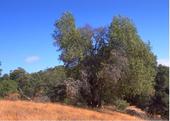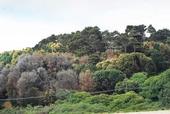- Author: Steven Swain

Sudden oak death (SOD) is a disease syndrome that has killed millions of native oak trees (Figure 1) along the west coast of the United States, from Big Sur in California up to Southern Oregon. The disease may involve several organisms, but its main driver is the fungus-like organism (known as water mold), Phytophthora ramorum. This plant pathogen is spread in the springtime by windy rainstorms. It infects the bark of oak trees, frequently creating bleeding trunk cankers that interfere with water uptake and sugar transport.
Death of SOD-infected trees can be accelerated by attacks from bark and ambrosia beetles. In the absence of beetle attacks, infected oaks may take years to die.
Many common...

In California, P. ramorum is primarily a leaf pathogen and thrives in coastal tanoak/redwood forests and oak woodlands. There are two categories of hosts for P. ramorum....
![Fig. 1 (a) Dying and dead Diplacus aurantiacus (orange bush monkeyflower) with advanced above ground symptoms, typical of Phytophthora disease. The infected plant has chlorotic (yellowing and browning) foliage. [L. Sims]](https://ucanr.edu/blogs/UCIPMurbanpests/blogfiles/40702small.jpg)
[From the December 2016 issue of the UC IPM Green Bulletin]
A new plant pathogen in the genus Phytophthora (pronounced Fie-TOF-ther-uh) has recently been found in several California native plant nurseries and habitat restoration sites. The pathogen, Phytophthora tentaculata, poses a risk of disease in wildlands, gardens and landscapes that use susceptible California native and non-native plants. Once introduced in these areas, the pathogen can generate disease for years to come, potentially causing lasting environmental and economic...


